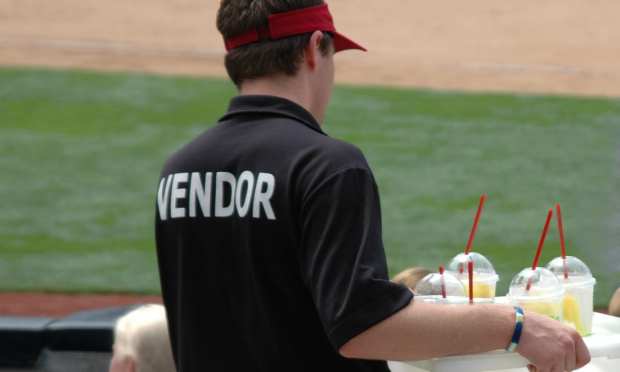Restaurant Digital Ordering Platform Expands Into Live Events

Before the pandemic, fear of touching items that others had touched was the near-exclusive purview of germaphobes. Now, living through a pandemic, even those of us who were previously the most oblivious to the contagion risks associated with our daily activities have become aware of the danger. Contactless ordering options have become more popular than ever, with QR codes becoming the norm rather than the exception. Consumers have come to expect digitization and the relative contagion-safety that it enables.
Now, as more and more U.S. adults are vaccinated, and a wide range of public places begin to reopen, contactless ordering platform BellyMelly is expanding its ordering and payment solutions, previously only found in restaurants, to live event venues including sporting arenas, amusement parks and performing arts spaces.
“Imagine in a baseball stadium or a football stadium, you’re sitting at your seat,” BellyMelly Founder David Litchman told PYMNTS in a recent interview. “There’s no vendors screaming popcorn, candy. I just imagine that the environment will be much more enjoyable for patrons. Their sightlines will be improved. You’ll be able to order from your phone … It’s going to happen — it’s clearly the direction the technology [is heading].”
How The Pandemic Has Accelerated Adoption
While the closures of dine-in restaurants may have posed a challenge for BellyMelly’s in-restaurant solutions, the past 13 months have created an enormous opportunity for the contactless tech company.
“Customers, restaurants who weren’t well positioned with online ordering clearly needed it,” said Litchman, “so that was certainly an opportunity for us to grow and expand into space. So, I’d say it’s been quite a ride. Very busy.”
In addition to providing its online ordering platform and its contact-free ordering and payment solutions, the company also offers a branded app service whereby it builds mobile apps for its restaurant customers with digital menus, ordering features, messaging platforms and rewards programs. Altogether, Litchman said, the company’s digital offerings give restaurants a chance to “leverage this new paradigm that we’re in” to attract and maintain customers. He expects that adoption of the technology will only continue to accelerate, even as consumers return to their pre-pandemic activities.
“Everything is going to move to a contact-free solution,” he predicted. “The pandemic has changed us. We are all cautious of what we touch, what we read, and what we do. So, anything that promotes a contact-free environment will be a successful strategy for most businesses.”
The One-Way Street Of Digital Evolution
To illustrate his prediction for the future of contact-free on-premises ordering and payment solutions, Litchman points to his experience with online ordering via desktop websites.
“Twenty years ago, I was in a restaurant business, and I had online ordering added to my website,” he recalled. “Reluctantly, customers started to use that tool. Now where did that trend go? Now online ordering is ubiquitous. Everyone can order from their phone and order from their website and their place order. Just, over time, the consumer adopted it and got comfortable with it.”
He notes that contactless ordering is following a similar trajectory, citing Chipotle Mexican Grill’s digital-only kitchen as an example of the sort of fully mobile-enabled restaurant space we can expect more of in the future. He predicted that the labor shortage that many restaurant industry experts are noting as we begin to emerge from the pandemic will only speed the adoption of these digital solutions.
“With the labor shortage, as well, as the cost of labor rises,” Litchman said, “these technologies will become a great solution for operators who’re trying to become more profitable and also safer. So I think ultimately it’s not going to go away, it’s only going to continue to expand, even without a pandemic coming again.”
He added that the technology tends to evolve toward efficiency, explaining, “It’s a more efficient technology …S o I think I think over time, it’s going to expand and evolve and more and more operators [and] restaurants will adopt this technology. It’s inevitable.”
Looking Ahead
As contact-free ordering expands to a wider range of spaces, Litchman said, it will have to overcome certain challenges, including the lack of consistently strong Wi-Fi and cellular service in many public areas. He added that “one of the biggest hurdles” facing the technology is the disconnect between wanting to provide a platform that can “collect payments at the time of the order” while also being able to “keep the tickets open.” However, he expects that these challenges will “be worked out” in years to come as demand for contact-free solutions remains high.
“We’ve been scarred, OK?” he said. “There are so many people who just — their comfort level is not going to return.”
He noted that contact-free ordering technology “creates a safer environment,” and that these technologies will offer a sense of security to consumers who, even as they return to public spaces full of other people, will continue to be aware of the associated risk.
“Ultimately as people start to adopt technology, as operators start to recognize value of that type of technology,” he predicted, “I think we’re going to start seeing more people ordering from their mobile devices in the stadiums, less lines at concession stands, and a safer, more enjoyable experience for all those involved.”
